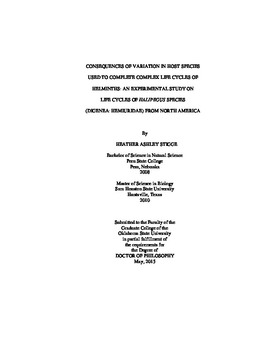| dc.contributor.advisor | Bolek, Matthew G. | |
| dc.contributor.author | Stigge, Heather Ashley | |
| dc.date.accessioned | 2016-09-29T18:37:04Z | |
| dc.date.available | 2016-09-29T18:37:04Z | |
| dc.date.issued | 2015-05 | |
| dc.identifier.uri | https://hdl.handle.net/11244/45210 | |
| dc.description.abstract | Complex life cycles, in which discrete life history stages of a parasite are transmitted sequentially between different host species, are shared by many parasites and have evolved independently in several phylogenetically distinct parasitic groups including protozoans, acanthocephalans, cestodes, nematodes, and trematodes. The multiple origins of complex life cycles have resulted in an astounding diversity in patterns of host usage among complex life cycles of helminths. Unfortunately, parasitologists have made generalizations about the life cycles of groups of helminths from the described life cycles of only one or few parasite species from within that group; therefore, much of the variation that likely exists in life cycles of different helminth species is lost, and life cycles are depicted to be invariable within and among species of parasites. At every stage of a life cycle, the parasite has a chance to infect numerous potential host species, but not all potential hosts are equally suited for the development and transmission of the parasite. The objectives of this dissertation were to experimentally examine the extent to which the variation in host usage influences life history traits of trematodes. Specifically, I was interested in evaluating how host usage influences transmission dynamics of parasites and their ability to complete life cycles. In chapter II, I discuss the host specificity of H. eccentricus and H. occidualis in 4 microcrustacean second intermediate hosts. I also evaluated the development of metacercariae within each host and estimated their contribution to the completion of the life cycles. My primary objective for the study presented in Chapter III was to experimentally evaluate the effects of using a paratenic hosts on life history traits of parasites within their subsequent host. In chapter IV, I present data that suggests that site fidelity of H. occidualis is more variable than previously described, and that the site occupied by these worms is dependent on the host species infected. Data presented in this dissertation provide the groundwork for future hypothesis-driven studies on the evolution complex life cycles of parasites. | |
| dc.format | application/pdf | |
| dc.language | en_US | |
| dc.rights | Copyright is held by the author who has granted the Oklahoma State University Library the non-exclusive right to share this material in its institutional repository. Contact Digital Library Services at lib-dls@okstate.edu or 405-744-9161 for the permission policy on the use, reproduction or distribution of this material. | |
| dc.title | Consequences of variation in host species used to complete complex life cycles of helminths: An experimental study on life cycles of Halipegus species (Digenea: Hemiuridae) from North America | |
| dc.contributor.committeeMember | Dzialowski, Andrew R. | |
| dc.contributor.committeeMember | Papes, Monica | |
| dc.contributor.committeeMember | Little, Susan E. | |
| osu.filename | Stigge_okstate_0664D_13906.pdf | |
| osu.accesstype | Open Access | |
| dc.type.genre | Dissertation | |
| dc.type.material | Text | |
| thesis.degree.discipline | Integrative Biology | |
| thesis.degree.grantor | Oklahoma State University | |
